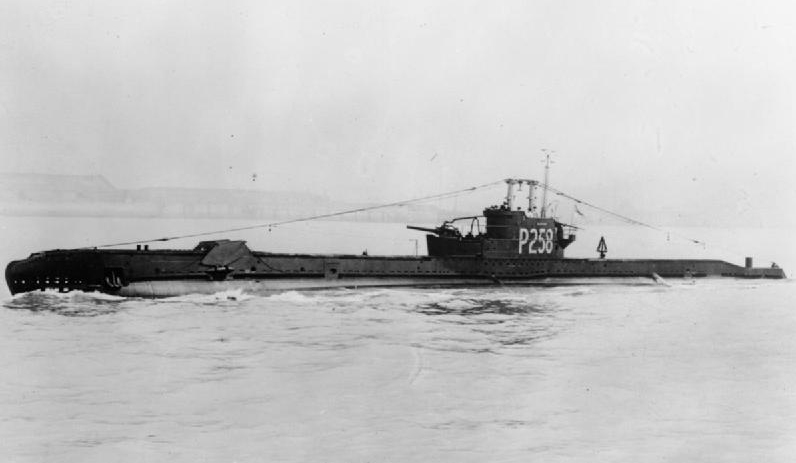S-Class Submarine

Battle Honours
None
Specifications
Builder: Cammell Laird Shipyard, Birkenhead, United Kingdom
Displacement: 814 tons
Length: 217 ft
Beam: 23 ft 8 in
Draught: 11 ft
Propulsion: 2 × 950 bhp (708 kW) diesel engines, 2 × 650 hp (485 kW) electric motors driving two propellers
Speed: 14.75 knots (16.97 mph; 27.32 km/h) surfaced. 9 knots (10 mph; 17 km/h) submerged
Range: 7,500 Nautical miles surfaced (8,600 mi; 13,900 km) at 10 knots (12 mph; 19 km/h) 120 Nautical miles submerged ( 140 mi; 220 km) at 3 knots (3.5 mph; 5.6 km/h)
Armament: 6 × bow & 1 stern 21 in (533 mm) torpedo tubes – carried 13 torpedoes or 12 mines; 1 × three-inch (76 mm) gun (QF 4-inch deck gun; 1 × 20 mm Oerlikon AA gun; 3 × .303 calibre machine guns
Crew complement: 48
Commanding Officers
Lt. P.E. Durham, Dec 1945
Lt. S. Jenner1947
Lt. G. Bourne 24 Apr 1950
Lt. B.C.G. Hutchings 13 Aug 1953
Lt. T.J. Andrews 29 Nov 1954
Lt. J.H. Parigter 6 Aug 1959
Related items
None
Reminiscences
None
Gallery
None
H.M. S/M SCORCHER

Image copyright IWM (FL 3688)
History
One of the final group of S Class submarines ordered for the Royal Navy she was built by Cammell Laird Shipyard Birkenhead, she was ordered on April 7th 1943, and her keel was laid down on December 14th 1943. She was launched almost a year to the day later on December 18th 1944.
On March 14th 1945 she departed her builders’ yard for Holy Loch, on the West coast of Scotland to begin a period of trials and training. Here she joined the 3rd Submarine Flotilla, attached to the depot ship HMS FORTH, which was responsible for submarines operating in the North Sea and Bay of Biscay and also the supervising of the trials and working up of all new construction submarines. She was commissioned as HMS SCORCHER March 16th 1945, at Holy Loch, Lt. K.S. Renshaw, DSC, RNR in command.
Having completed her work-up HMS SCORCHER departed Rothesay for Scapa Flow escorted by the destroyer HMS SHIKARI on April 6th 1945, Between April 8th & April 21st she took part in Anti Submarine exercises. SCORCHER, in company with submarines HMS TAPIR and HMS TOTEM, departed Scapa Flow for Holy Loch on April 22nd escorted by HMS HASTINGS.
Allocated to the East Indies Fleet
HMS SCORCHER was allocated for service with the East Indies Fleet and after storing ship and final crew members were aboard she sailed for Gibraltar on June 27th on the first leg of her voyage to Ceylon, After a fuel stop at Gibraltar, July 1st - 3rd, she proceeded to Malta where she arrived on the 7th. She departed Malta on the 11th, arriving at Port Said on July 18th to await passage through the Suez Canal; six days later, she sailed for Aden. After an overnight stop SCORCHER departed Aden on July 30th on her final leg for Trincomalee, arriving there on August 8th. On August 15th Japan surrendered.
SCORCHER was to make a single patrol as part of the East Indies Fleet; she sailed on August 28th on a weather reporting patrol to the North-West of Sumatra, returning to Trincomalee on September 18th. Surplus to requirements HMS SCORCHER was ordered to return to the UK; she departed Trincomalee on October 4th bound for Aden. She arrived back at Rothesay on November 11th 1945.
Post War history
After the war the surviving S Class boats were refitted to install a folding snorkel mast aft of the control tower; to accommodate this the stern torpedo tube and the 'Bandstand' Anti-Aircraft platform and 20mm Oerlikon were removed. Some had their main deck gun removed as well. The snorkel allowed a submarine to cruise on diesel engines while submerged allowing the batteries to be recharged without the need to surface and risk detection by an enemy. When raised the ‘snort’ was the only part of the boat above the surface drawing in clean air while discharging the toxic diesel exhaust. Later modernisation work included installation of an improved sonar mounted in a dome on the casing above the forward dive plane and improved radar.
On emerging from her modification refit SCORCHER was allocated to the 2nd Submarine Flotilla, attached to the depot ship HMS MAIDSTONE at Portland in She returned to Active duty in 1948 under the command of Lieutenant S. Jenner R.N. He was relieved by Lieutenant G. Bourne in April 1950. In April 1951 SCORCHER, along with her sisters, HMS SIRDAR and SCYTHIAN, took part in the unsuccessful search for the missing Submarine HMS AFFRAY.
She transferred to the 3rd Submarine Flotilla attached to the depot ship HMS MONTCLARE, at Rothesay later in 1951. In June 1953 she took part in the Fleet Review to celebrate the Coronation of Queen Elizabeth II. Lieutenant B.C.G. Hutchings took over as commanding officer in August 1953.
She was reallocated to the 5th Submarine Squadron based at HMS DOLPHIN, Gosport in 1954 under the command of Lieutenant T.J. Andrews from November that year. In 1956 She was reallocated to the 2nd Submarine Squadron attached to the depot ship HMS TYNE at Portland. She had tow serious incidents during the year 1956; she was damaged in a collision on February 4th and suffered a fire during exercises on November 22nd.
SCORCHER was placed in the Reserve Fleet in 1958 and was later put up for disposal. She was broken up at Charlestown in 1962.
Last modified: 23 February 2023
Primary information sources
Additional sources:
uboat.net entry for H.M. Submarine SCORCHER
Comments (1)
Did HMS Scorcher engage any enemy vessels on her journey to Ceylon ?
My father Henry W Thorpe served aboard during this time.